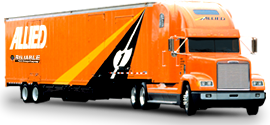As your moving day gets closer and closer, things get more and more hectic – but dogs rely on stability to feel secure. All of the commotion that comes with moving can really unsettle them. Below are a few tips to help transition your dog into his new home.
 Prep him for the move with a few kind words of encouragement. Keep in mind that your dog reacts to your emotional state and unless you’re made of stone, chances are the move is stressing you out. Your pup may respond to your new emotional trauma with skittish or anxious behavior that he never seemed to exhibit before. Spend some time telling him about the move and try to get him used to the words “move”, “new home”, and “packing”. Comfort your pup as he will need it once he sees all his stuff being packed into boxes. Reassure him that everything is going to be ok. A few of my things in a tight space. Cramped spaces provide a dog with a sense of comfort and warmth. If you crated your dog as a pup, you’ll be happy to find that his crate will be his comfort space in your new home. If you haven’t trained your dog to use a cage, invest in a hut for your buddy prior to the move. Introduce him to his new house before you actually move so he has time to get familiar with it and make it his own. Fill his hut with his favorite toys and a few treats that will help him acclimate. Make his hut the last thing to remove from your old home, and make it the first thing that enters your new home. Visit your new abode. If you can, take your pup to your new home before you move. Let him explore the new sights, sounds, and scenery so he is less shocked to be in a new setting come moving day. Take him for a walk around the new neighborhood and let him sniff the place out. If possible, leave an old toy of his behind somewhere in your new residence. When you return, your dog will be able to associate his toy with his first exploratory experience in your new dwelling. Remember that dogs react to their owner’s state of mind. So if you act excited about your new home, it’s likely that he will be excited too! Something old, something new. As tempting as it is to redecorate your new home, you’ll want to hold off for just a bit on replacing your pooch’s possessions. Put down his old bed and dishes in your new residence and your pup will be comforted by the mere presence of his things. You can couple his old belongings with a few new toys and your dog will think his new house is the reward of a lifetime. Chemicals and Canines. Your new home can be filled with the scent of fresh paint and, upon your first few days there, the putrid and dangerous fumes of cleaning products. The last thing you or your dog need are the harmful VOC’s creeping into his lungs. If your new home doesn’t have an outside space suitable for your pup, you’ll want to find a safe place for him while you paint or clean. Ask a neighbor or friend to dog-sit for a few hours. If no one can watch your pup, purchase organic cleaning products or those whose label clearly states that they are made from natural, non-toxic products, or suitable for pets and children. Try to keep your home as ventilated as possible as dogs are just as susceptible, if not more. Take into account their acute sense of smell, and consider the toxins that inhabit most cleaning or painting products.
Prep him for the move with a few kind words of encouragement. Keep in mind that your dog reacts to your emotional state and unless you’re made of stone, chances are the move is stressing you out. Your pup may respond to your new emotional trauma with skittish or anxious behavior that he never seemed to exhibit before. Spend some time telling him about the move and try to get him used to the words “move”, “new home”, and “packing”. Comfort your pup as he will need it once he sees all his stuff being packed into boxes. Reassure him that everything is going to be ok. A few of my things in a tight space. Cramped spaces provide a dog with a sense of comfort and warmth. If you crated your dog as a pup, you’ll be happy to find that his crate will be his comfort space in your new home. If you haven’t trained your dog to use a cage, invest in a hut for your buddy prior to the move. Introduce him to his new house before you actually move so he has time to get familiar with it and make it his own. Fill his hut with his favorite toys and a few treats that will help him acclimate. Make his hut the last thing to remove from your old home, and make it the first thing that enters your new home. Visit your new abode. If you can, take your pup to your new home before you move. Let him explore the new sights, sounds, and scenery so he is less shocked to be in a new setting come moving day. Take him for a walk around the new neighborhood and let him sniff the place out. If possible, leave an old toy of his behind somewhere in your new residence. When you return, your dog will be able to associate his toy with his first exploratory experience in your new dwelling. Remember that dogs react to their owner’s state of mind. So if you act excited about your new home, it’s likely that he will be excited too! Something old, something new. As tempting as it is to redecorate your new home, you’ll want to hold off for just a bit on replacing your pooch’s possessions. Put down his old bed and dishes in your new residence and your pup will be comforted by the mere presence of his things. You can couple his old belongings with a few new toys and your dog will think his new house is the reward of a lifetime. Chemicals and Canines. Your new home can be filled with the scent of fresh paint and, upon your first few days there, the putrid and dangerous fumes of cleaning products. The last thing you or your dog need are the harmful VOC’s creeping into his lungs. If your new home doesn’t have an outside space suitable for your pup, you’ll want to find a safe place for him while you paint or clean. Ask a neighbor or friend to dog-sit for a few hours. If no one can watch your pup, purchase organic cleaning products or those whose label clearly states that they are made from natural, non-toxic products, or suitable for pets and children. Try to keep your home as ventilated as possible as dogs are just as susceptible, if not more. Take into account their acute sense of smell, and consider the toxins that inhabit most cleaning or painting products. Moving with your dog is a challenge for the both of you. For your pet’s sake, take a few extra moments to ensure you’re making the process as easy and stress-free as you possibly can for your dog. Dogs are sensitive creatures, and they rely on their owners to make difficult situations less challenging. Don’t ignore your dog’s needs and feelings during this hectic time. At the end of a long day, it’s your dog that provides you comfort. Return the favor by making your move a bit easier on him, which in turn will also be easier on you.
Jennifer AngelSubscribe to Reliable Van And Storage's Blog










Comments